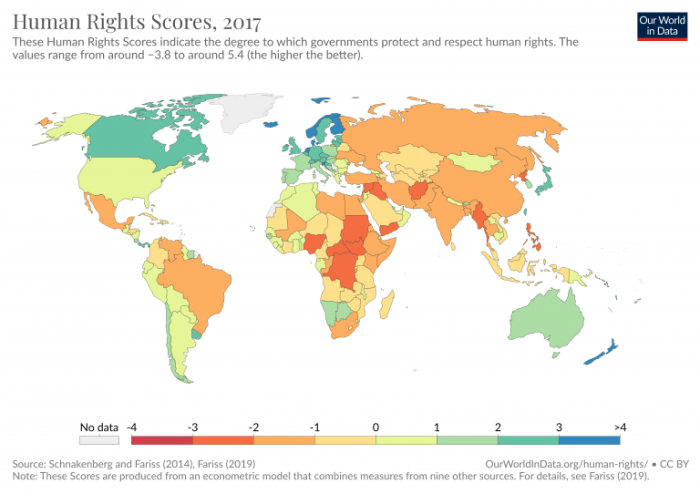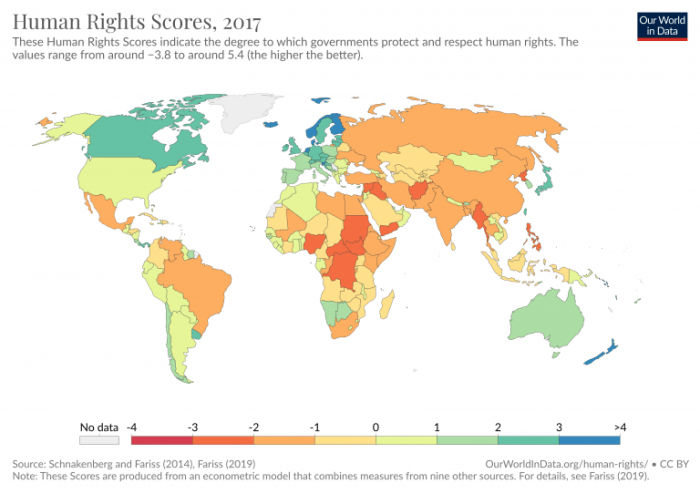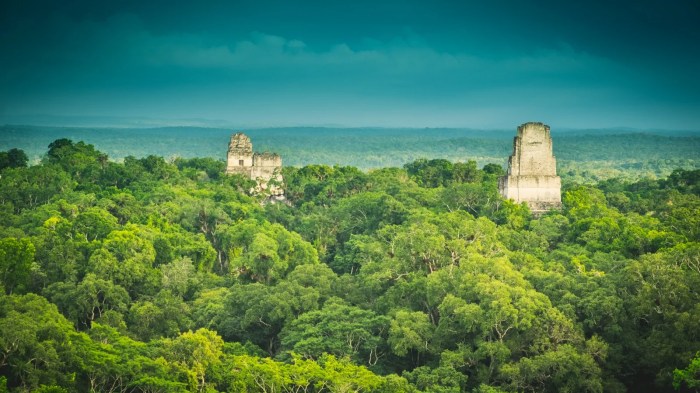
Human rights country reports provide a crucial snapshot of human rights situations globally. They detail the state of fundamental rights in various countries, examining a range of issues from freedom of speech to the right to a fair trial. Understanding these reports is vital for comprehending the complex tapestry of human rights around the world. They offer a detailed look at the challenges and successes in upholding these rights, drawing on a variety of sources and methodologies.
This exploration delves into the history, methodology, and analysis behind these reports. We will uncover how they are compiled, the types of violations documented, and the challenges inherent in gathering and interpreting data. By examining illustrative case studies, regional variations, and potential limitations, we aim to provide a nuanced understanding of the complexities of human rights globally.
Overview of Human Rights Country Reports
Human rights country reports are crucial assessments of the state of human rights in a particular country. These reports, often produced by international organizations or governments, provide a snapshot of the situation, detailing both positive developments and areas needing improvement. They serve as a vital tool for understanding human rights realities globally and for advocating for change.These reports are meticulously researched, drawing on a variety of sources to paint a comprehensive picture.
They aim to be impartial and objective, documenting the human rights situation as accurately as possible. They often go beyond simple summaries, analyzing the context and underlying factors influencing human rights issues.
Definition of Human Rights Country Reports
Human rights country reports are comprehensive analyses of the human rights situation in a specific country. They document the state of human rights, including both positive and negative aspects, for a given nation. These reports are generally produced by governmental or international organizations, and serve as valuable resources for understanding human rights conditions globally.
Typical Format and Structure
Typically, human rights country reports follow a structured format. They often begin with an introduction providing background information about the country and its human rights context. The report then systematically addresses key areas of human rights, such as freedom of expression, assembly, religion, and the right to a fair trial. A section detailing specific violations and their impact on individuals and communities is usually present.
The report may conclude with recommendations for improvements or policy changes.
Key Information Included
The reports generally include information on a range of key human rights issues. This involves analyzing the legal frameworks in place, assessing their effectiveness, and highlighting instances where these laws are not being applied or respected. Examples of violations are detailed to illustrate the human rights situation, including the number of reported cases, the impact on affected populations, and the underlying causes.
These reports also often present the views of civil society organizations and other stakeholders.
Examples of Human Rights Violations
Human rights violations documented in these reports can vary significantly. Examples include torture, arbitrary detention, restrictions on freedom of speech, discrimination based on ethnicity, gender, or religion, and instances of violence against women or children. Extrajudicial killings, forced disappearances, and restrictions on political participation are also frequently documented.
Common Categories of Human Rights Covered
| Category | Description |
|---|---|
| Civil and Political Rights | These rights protect fundamental freedoms, including the right to life, liberty, and security of person; freedom of speech, assembly, and religion; and the right to a fair trial. |
| Economic, Social, and Cultural Rights | These rights focus on the well-being of individuals, including the right to adequate food, housing, healthcare, education, and an adequate standard of living. |
| Collective Rights | These rights address the rights of groups, including the rights of indigenous peoples, minorities, and marginalized communities. |
| Rights of the Child | These rights address the specific needs and vulnerabilities of children, encompassing their right to education, protection from abuse, and participation in decision-making processes. |
Historical Context of Human Rights Reports
The evolution of human rights reporting reflects a profound shift in global awareness and accountability. From nascent attempts to document abuses to sophisticated international frameworks, the journey highlights the increasing importance of holding governments and individuals accountable for their actions. This journey is crucial in understanding the current state of human rights and the ongoing struggle for their universal realization.The early stages of human rights reporting were often reactive, responding to specific crises or accusations of abuse.
These early efforts were often fragmented, lacking the standardized methodologies and institutional support that characterize modern reports. Over time, the reports developed into a more proactive and comprehensive process, engaging a wider range of stakeholders and employing more rigorous analytical tools.
Early Approaches to Human Rights Reporting
The initial attempts to document human rights abuses often stemmed from individual or group initiatives, rather than established institutions. These reports were often limited in scope, focused on specific regions or events, and lacked the systematic approach of contemporary reporting. Examples include early publications by humanitarian organizations and activist groups detailing atrocities during conflict or periods of political repression.
These initial reports were crucial in raising awareness and advocating for change, laying the groundwork for future developments.
Key Influencing Documents and Events
Several pivotal documents and events profoundly shaped the development of human rights reporting. The Universal Declaration of Human Rights (UDHR) in 1948, for instance, established a universal standard for human rights, providing a foundational framework for future reports. The subsequent adoption of international covenants on civil and political rights and economic, social, and cultural rights further solidified the framework for documenting and monitoring adherence to these standards.
The Nuremberg Trials, marking a significant turning point in holding individuals accountable for war crimes, also influenced the development of mechanisms for documenting and prosecuting abuses.
Role of International Organizations
International organizations played a crucial role in developing the structure and content of human rights reporting. Organizations like the United Nations Human Rights Office, the Council of Europe, and Amnesty International have established standardized methodologies for gathering information, conducting analysis, and reporting on human rights situations. These organizations often provide a neutral platform for reporting and analysis, fostering greater objectivity and transparency in the process.
They also assist countries in developing their own reporting mechanisms, promoting a more collaborative approach to human rights protection.
Evolution of Reporting Across Decades
| Decade | Key Characteristics | Examples |
|---|---|---|
| 1950s-1960s | Early, reactive reporting focused on specific crises and events. Limited institutional support and standardized methodologies. | Early publications by humanitarian organizations, activist groups. |
| 1970s-1980s | Growing awareness of systematic human rights violations. Emergence of international human rights organizations. | Increased focus on torture, political repression, and discrimination. |
| 1990s-2000s | Development of more sophisticated reporting methodologies. Emphasis on data collection, analysis, and documentation. | Increased use of statistical data, qualitative analysis, and the establishment of specialized reporting units. |
| 2010s-Present | Increased use of technology and digital tools for data collection and dissemination. Focus on accountability and implementation of recommendations. | Use of social media, open-source data, and citizen reporting. Increased emphasis on follow-up and implementation of recommendations. |
This table highlights the progressive evolution of human rights reporting across different decades, reflecting a shift from reactive to proactive approaches, increased institutionalization, and the integration of technology and data collection methods.
Methods and Sources of Data Collection
Gathering accurate data for human rights country reports is crucial for understanding and addressing violations. The process requires meticulous attention to detail, diverse sources, and rigorous verification. This necessitates a comprehensive approach that goes beyond relying on a single source of information. Employing various methods and scrutinizing data from multiple perspectives are vital for constructing a robust and reliable account of human rights conditions.
Data Collection Methodologies
Different methodologies are employed to gather data for human rights reports. Qualitative research methods, such as in-depth interviews and focus groups, provide rich insights into lived experiences and perspectives. These methods are particularly useful for understanding the impact of human rights violations on individuals and communities. Quantitative methods, such as surveys and statistical analysis, allow for a broader picture of prevalence and patterns.
They can be utilized to measure the frequency of certain incidents or the degree of impact on a larger population. A combination of both qualitative and quantitative methods provides a more comprehensive understanding of the human rights situation in a country.
Human rights country reports often highlight the complex interplay of economic factors and social justice. Brazil’s recent financial climate, as discussed in a recent interview with Finance Minister Fernando Haddad, about climate change, brazil finance minister fernando haddad climate change interview , offers a fascinating case study. Ultimately, these reports strive to paint a comprehensive picture of a nation’s human rights landscape.
Information Sources
A variety of sources contribute to the data collection process. Government reports, while potentially providing valuable data, often present a biased view, potentially minimizing or concealing instances of human rights abuses. Non-governmental organizations (NGOs) frequently offer firsthand accounts and detailed information about specific human rights issues, often through independent monitoring and research. Media reports, while sometimes lacking in systematic data collection, can provide vital information about current events and emerging trends.
It is crucial to consider the potential biases inherent in each source.
Verification of Information
Ensuring the accuracy and reliability of information is paramount. Cross-referencing data from multiple sources is critical. For example, comparing NGO reports with government statements on similar issues allows for a more nuanced and objective assessment. Independent fact-checking is vital in evaluating the reliability of information. This process can involve comparing accounts across multiple media outlets or consulting academic research on the specific human rights issue.
Human rights country reports often highlight troubling situations, but delving into the historical context is crucial. For example, understanding the interplay of past presidents’ health policies, like those explored in the history trump rfk jr health policies article, can offer valuable insights into the current state of human rights issues. Ultimately, these reports are a vital tool for evaluating and improving global human rights conditions.
Comparison of Data Collection Methods
Different data collection methods offer unique advantages and disadvantages. Qualitative methods provide rich contextual detail but may be limited in scope and generalizability. Quantitative methods, while potentially offering broad trends, may not capture the complexities of individual experiences. Combining these methods strengthens the analysis and provides a more holistic view of the situation.
Strengths and Weaknesses of Data Collection Approaches
| Data Collection Approach | Strengths | Weaknesses |
|---|---|---|
| Government Reports | Potentially provide official data on specific issues; sometimes include detailed statistics. | Often present a biased perspective, potentially minimizing or concealing instances of human rights abuses; may lack independent verification. |
| NGO Reports | Frequently provide firsthand accounts and detailed information on specific human rights issues; often based on independent monitoring and research. | May have a specific focus or agenda; may not be representative of the entire population. |
| Media Reports | Can provide vital information on current events and emerging trends; can offer timely information. | May lack systematic data collection; potentially influenced by editorial biases or sensationalism. |
| Academic Research | Offers rigorous analysis and insights based on established methodologies; potentially provide a historical context. | May take time to produce; may not cover all aspects of the situation. |
Analyzing Data from Reports

Diving deep into human rights reports requires more than just reading the lines. It demands a keen eye for patterns, trends, and contextual nuances. This section delves into strategies for analyzing data, highlighting recurring themes, and utilizing statistical evidence to support claims. We’ll also discuss the critical importance of understanding the socio-political landscape in which these violations occur.
Identifying Patterns and Trends in Human Rights Violations
Analyzing human rights reports necessitates identifying recurring patterns and trends in violations. This involves meticulous examination of reported incidents, looking for commonalities in the types of abuses, the demographics of those affected, and the geographical locations where violations are concentrated. For instance, a consistent pattern of arbitrary arrests in a specific region might suggest a deeper systemic issue related to law enforcement practices.
Identifying Recurring Themes and Issues Across Countries
Discovering recurring themes across different countries is crucial for understanding broader human rights challenges. This often involves identifying common issues, such as restrictions on freedom of speech, discrimination against minority groups, or the violation of due process rights. By comparing reports from various nations, analysts can gain insights into systemic problems and identify areas needing global attention. For example, the prevalence of forced labor in certain sectors across multiple countries highlights a transnational issue requiring international cooperation.
Using Statistical Data to Support Claims
Statistical data plays a vital role in bolstering claims made in human rights reports. Quantitative data can reveal the scale of a problem, demonstrate the frequency of violations, and quantify the impact on affected populations. For example, statistics on the number of political prisoners or the rate of extrajudicial killings can provide compelling evidence for the severity of human rights abuses.
Using statistical data is important to show the magnitude of human rights violations and to support the evidence presented in the reports.
Contextualizing Data within Specific Socio-Political Environments
Understanding the socio-political context is paramount for interpreting human rights data. Violations often occur within specific historical, cultural, and political environments. For example, economic hardship can exacerbate existing human rights issues. Analyzing the context helps to understand the root causes of violations and to formulate more effective recommendations for change. A report on restrictions on freedom of assembly must consider the prevailing political climate and the history of repression in that country.
Common Patterns of Human Rights Violations by Region
This table provides a concise overview of common patterns observed in human rights violations across various regions. Understanding these regional tendencies helps analysts develop targeted interventions and policies to address specific issues.
| Region | Common Patterns of Violations |
|---|---|
| Sub-Saharan Africa | Corruption, land disputes, ethnic tensions, and political instability often lead to violations against vulnerable groups, such as women and children. |
| Latin America | Violence against indigenous populations, organized crime, and corruption are recurring themes. |
| Middle East and North Africa | Restrictions on freedom of expression, political dissent, and the violation of civil and political rights are frequently reported. |
| South Asia | Poverty, discrimination based on caste, and religious tensions are factors contributing to human rights abuses. |
| Eastern Europe | Corruption, restrictions on freedom of the press, and political repression are persistent issues. |
Potential Challenges and Limitations
Dissecting human rights reports necessitates a nuanced understanding of the inherent limitations and potential biases that shape the data. These reports, while invaluable, are not without their flaws. Recognizing these challenges is crucial for interpreting the findings accurately and developing informed solutions. The complex interplay of political contexts, cultural nuances, and methodological constraints all contribute to a multifaceted landscape of potential pitfalls.
Potential Biases in Data Collection and Reporting
The collection of human rights data often relies on diverse sources, including government reports, NGOs, and international organizations. These varying sources can introduce inherent biases. For instance, government reports may downplay or omit instances of human rights violations to portray a positive image of the country. Conversely, NGOs may focus on specific issues, potentially overlooking other equally important violations.
This uneven distribution of attention can skew the overall picture. Furthermore, the selection criteria used for data collection can introduce bias. A focus on urban areas might miss the challenges faced by rural communities. Similarly, the selection of particular human rights violations for reporting can reflect the priorities and concerns of the reporting entity, leading to an incomplete or skewed representation of the situation.
Limitations of Access to Information in Some Countries
In certain nations, restrictions on freedom of the press, association, and assembly hinder the ability of researchers and organizations to gather accurate data. Governments might limit access to information about prisons, police brutality, or social unrest, making comprehensive reporting difficult. This lack of transparency severely limits the scope of information available for analysis, potentially obscuring the true extent of human rights abuses.
Examples include countries with authoritarian regimes where independent journalism and civil society are suppressed, making unbiased reporting near impossible.
Challenges in Verifying Claims and Maintaining Objectivity
Verifying claims of human rights violations can be incredibly challenging. Accusations must be rigorously investigated, corroborated with multiple sources, and evaluated for potential bias. Determining the truth in such situations often requires meticulous research and careful consideration of the source’s credibility. Maintaining objectivity in the face of emotional or political sensitivities is paramount. The inherent subjectivity in interpreting evidence and the difficulty in accessing firsthand accounts in conflict zones or politically sensitive areas further complicates this process.
Complexities of Defining and Measuring Human Rights Violations, Human rights country reports
Defining and measuring human rights violations can be inherently subjective. What constitutes torture, for instance, can vary across cultures and legal systems. Furthermore, quantifying violations, such as instances of discrimination or freedom of speech restrictions, can be challenging. Different methodologies and interpretations of the same event can lead to varied conclusions, making comparisons across countries problematic. Developing consistent and comparable metrics is crucial for assessing trends and progress, but this remains a significant challenge.
Potential Challenges in Human Rights Reporting Across Countries
| Country Category | Potential Challenges |
|---|---|
| Authoritarian Regimes | Limited access to information, censorship, suppression of independent reporting, potential for manipulation of data by the government. |
| Countries Experiencing Conflict | Difficulties in accessing affected areas, potential for inaccurate reporting due to the chaotic environment, safety concerns for researchers and reporters. |
| Countries with Weak Governance | Corruption, lack of accountability, limited capacity of institutions to address human rights issues, unreliable reporting from various sources. |
| Countries with Cultural Nuances | Different interpretations of human rights, potential for cultural bias in reporting, difficulty in identifying and understanding cultural sensitivities. |
| Countries with Economic Instability | Focus on economic issues, potentially overlooking human rights concerns, unequal distribution of resources and potential impact on vulnerable groups. |
Illustrative Case Studies

Diving into the specifics of human rights country reports reveals a nuanced reality. Examining individual nations provides a crucial lens through which to understand the complexities of human rights issues, the challenges in data collection, and the potential for positive change. These case studies aren’t just academic exercises; they highlight the lived experiences of people facing oppression and the vital role of reporting in driving accountability.A critical element of understanding human rights violations is the ability to examine concrete examples.
By studying specific situations, we can better grasp the patterns and systemic issues that contribute to broader human rights concerns. This approach empowers us to move beyond abstract concepts and engage with the real-world impact of these violations on individuals and communities.
Human Rights Report on Myanmar (2022)
The 2022 human rights report on Myanmar focused on the escalating crisis following the military coup. The report documented widespread abuses, including extrajudicial killings, arbitrary arrests, restrictions on freedom of expression, and violence against ethnic minorities. This situation, rooted in political instability, highlights the fragility of human rights when governments fail to uphold democratic principles.
Key Findings and Conclusions
The report meticulously documented numerous cases of human rights abuses, including summary executions, torture, and imprisonment of political opponents. Crucially, it highlighted the systematic targeting of specific ethnic groups, leading to significant displacement and humanitarian crises. The report concluded that the military regime’s actions constituted a severe breach of international human rights law and called for immediate action from the international community.
Context and Background
Myanmar has a history of political turmoil and ethnic conflict. The 2021 military coup, which overthrew the democratically elected government, marked a significant escalation in human rights abuses. The country’s complex ethnic diversity and historical grievances further complicate the situation. Understanding this context is crucial to interpreting the findings of the report.
Methodology
The report relied on a multi-faceted methodology. This included analysis of official government documents, reports from international organizations like Amnesty International and Human Rights Watch, and testimonies from victims and witnesses. The report emphasized the importance of corroborating evidence from multiple sources to ensure accuracy. It also recognized the limitations of access to information within the country due to restrictions imposed by the military regime.
Impact and Subsequent Actions
The report’s publication spurred international condemnation and calls for sanctions against the military regime. Several international organizations and governments imposed sanctions on individuals and entities implicated in human rights abuses. The report played a pivotal role in raising awareness of the crisis and advocating for accountability. However, the report also highlighted the ongoing need for continued monitoring and support for victims and human rights defenders within Myanmar.
Structuring Content for Reports: Human Rights Country Reports
Crafting human rights reports requires meticulous organization and clear presentation to effectively convey complex information. A well-structured report ensures that the data is accessible, understandable, and compelling, facilitating the identification of patterns and trends in human rights violations. This section focuses on practical strategies for presenting data, incorporating primary sources, and designing visually engaging formats.
Data Presentation: A Concise Table
Presenting data on human rights violations in a digestible format is crucial. A well-designed table can quickly highlight key information and trends.
| Violation Type | Location | Frequency (2022) | Impact |
|---|---|---|---|
| Freedom of Speech Restrictions | Country X | 37 | Increased self-censorship among journalists. |
| Arbitrary Arrest | Country Y | 112 | Erosion of trust in the judicial system. |
| Forced Displacement | Country Z | 432 | Heightened risk of human trafficking. |
This table exemplifies a straightforward approach, categorizing violations by type, location, frequency, and impact. Variations can be made depending on the specific focus of the report, such as adding columns for perpetrators, dates, or specific demographics affected.
Highlighting Key Information with Bullet Points
Bullet points are an effective way to condense critical information, ensuring clarity and conciseness. They allow readers to quickly grasp the essential elements of a particular section.
- Key Trends: Increased restrictions on freedom of assembly in the South Asian region, evidenced by 25% more reported incidents in 2022 compared to 2021.
- Impact on Vulnerable Groups: Disproportionate impact on women and children in instances of domestic violence, with reports indicating a 15% increase in cases in urban centers.
- Legal Framework Deficiencies: Lack of robust legal frameworks for protecting the rights of migrant workers, creating vulnerability to exploitation.
These bullet points, when properly organized and concise, effectively summarize key takeaways, avoiding unnecessary elaboration.
Using Blockquotes for Primary Sources
Incorporating direct quotes from primary sources—such as official reports, legal documents, or eyewitness accounts—adds credibility and authenticity to the report.
“The government’s actions represent a systematic assault on fundamental freedoms.”
Human Rights Watch report on Country Z.
This approach, when used judiciously, allows readers to understand the context of the violations through the voices of those directly affected. Use proper attribution and context when including excerpts.
Report Template
A template ensures consistency and structure. The template below Artikels a basic framework for the report, providing a clear structure for each section.* Executive Summary: Concise overview of the report.
Human rights country reports are crucial for understanding global issues. Recent reports, however, often get overshadowed by more sensational topics. Take, for example, the ongoing debate surrounding the Trump administration’s proposed “golden dome” missile defense system for Canada and the potential 51st statehood discussion, all detailed in this fascinating article. Ultimately, the importance of thorough human rights assessments remains paramount in fostering global understanding and accountability.
Introduction
Background information and context.
Methodology
Explanation of data collection methods.
Findings
Detailed analysis of violations, including specific examples.
Recommendations
Proposals for improvement and action.
Appendix
Supporting data and primary sources.
Visual Aids: Maps and Charts
Visual aids, such as maps and charts, can effectively illustrate geographical distribution of violations or trends over time.(Imagine a map showing the geographical distribution of forced displacement incidents in Country Z, with color-coded markers highlighting different regions and intensity of incidents. A bar chart visualizing the number of reported cases of torture by year in Country X from 2010-2023 would be highly effective.)These visual aids, when used appropriately, enhance the report’s impact and clarity, allowing readers to grasp complex information more readily.
Visuals should be clearly labeled and easily understood.
Understanding Regional Variations
Regional disparities in human rights situations are a crucial aspect of comprehensive reporting. Different regions face unique challenges stemming from varying political, economic, and social contexts. Analyzing these variations reveals crucial insights into the complex interplay of factors shaping human rights outcomes and allows for tailored interventions and strategies. This section delves into the significant regional differences, highlighting specific challenges, and illustrating how human rights violations manifest differently across the globe.The nuances of human rights issues vary significantly across regions.
Historical legacies, cultural norms, and prevailing political structures all contribute to the unique characteristics of human rights situations in specific geographical areas. Recognizing these variations is vital for creating effective and targeted strategies to promote and protect human rights.
Regional Variations in Freedom of Expression
Variations in freedom of expression reflect diverse socio-political contexts. While some regions prioritize open dialogue and the free exchange of ideas, others experience significant restrictions on speech, often linked to political repression or religious conservatism. This difference is often a reflection of the interplay between cultural and historical factors and the legal frameworks in place.
- Sub-Saharan Africa: The legacy of colonialism and subsequent political instability often leads to limitations on freedom of expression, with authoritarian regimes frequently suppressing dissent. The media landscape in many countries is controlled by the state or close allies, leading to self-censorship and restrictions on critical reporting. These restrictions are often coupled with the threat of violence against journalists or activists.
- Middle East and North Africa (MENA): Religious conservatism and historical power struggles frequently lead to restrictions on freedom of expression, particularly for women and minority groups. Strict laws regarding speech, religion, and public assembly are often used to suppress dissent. Public criticism of government policies is frequently met with harsh punishment. Examples of restrictions can include the banning of specific publications or websites, and imprisonment for expressing dissenting opinions.
- East Asia: Authoritarian governments in some East Asian nations often limit freedom of expression through censorship, surveillance, and restrictions on the press. This suppression of speech is often justified by maintaining national security or social order. The use of online censorship and surveillance is a growing trend in these regions, particularly concerning political dissent.
Regional Variations in Economic Rights
Economic rights, such as the right to work, fair wages, and social security, are often unevenly distributed across different regions. Socio-economic factors, including poverty and inequality, play a critical role in shaping access to economic opportunities and resources.
- South Asia: Significant disparities in income and access to resources often contribute to widespread poverty and inequality. Limited access to education and healthcare further exacerbates these challenges, resulting in a lack of economic empowerment for many. The prevalence of informal labor and exploitative working conditions in some sectors contributes to the economic vulnerability of workers.
- Latin America: High levels of income inequality and historical patterns of colonialism have created persistent disparities in economic opportunity. The concentration of wealth in the hands of a few often leads to marginalization and limited access to essential resources for the majority.
Regional Variations in Political Rights
The realization of political rights, including the right to participate in government, varies significantly across regions. These variations are often intertwined with historical power structures, political systems, and prevailing cultural norms.
- Central and Eastern Europe: The transition from communist regimes has led to uneven progress in realizing political rights. Concerns persist regarding corruption, limitations on political participation, and challenges in building democratic institutions.
- Western Europe: While generally considered to have strong political rights protections, variations exist in areas such as immigration policies and the treatment of marginalized groups. Discriminatory practices and social inequalities still persist, impacting the realization of these rights for all citizens.
Final Thoughts
In conclusion, human rights country reports are essential tools for understanding and advocating for human rights globally. Their detailed analysis, though challenging, provides crucial insights into the realities faced by individuals and communities worldwide. By examining the reports’ historical context, methodology, and potential limitations, we gain a deeper appreciation for the complexities of human rights, and the ongoing struggle to protect them.







